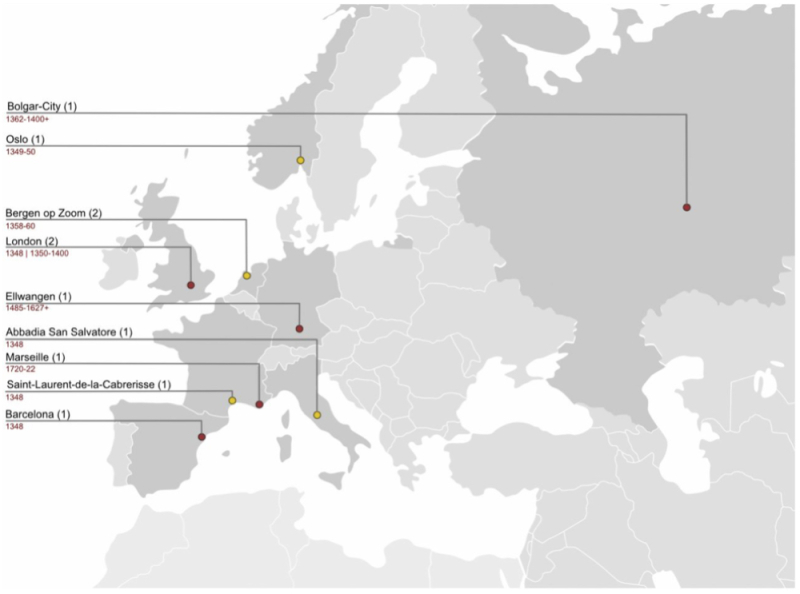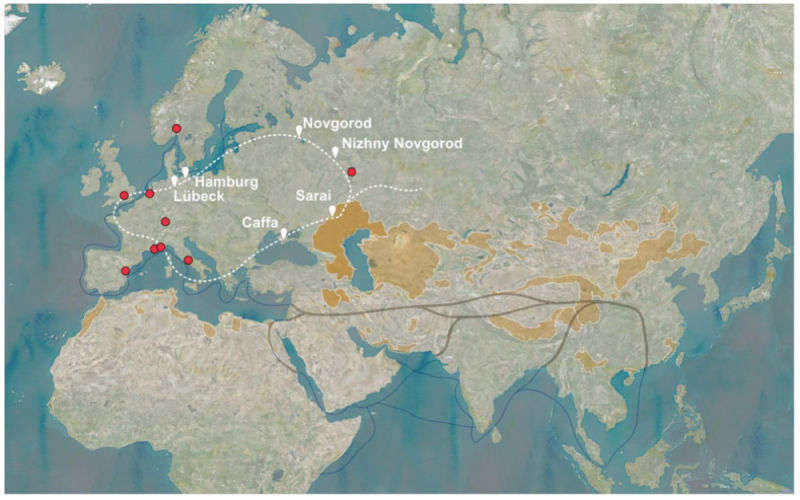
The plague, that variety of human ailments caused by the Yersinia pestis bacteria, is mythic in human history, a nightmare disease carried by fleas infesting rats, a species that is omnipresent in human civilizations. Its spread in earlier times was a nascent harbinger of the much more global spread of disease today, due to the greater reach of modern transportation compared with, inter alia, sailing ships and overland caravans. The precise nature and pattern of earlier outbreaks is relatively unknown, however, and their routes of transmission somewhat speculative. In view of the consequences of a plague pandemic today (despite the existence of antibiotics, still a risk due to supply chain weaknesses and other factors) this lack of knowledge is relevant to understanding and forestalling modern global public health risks.
A group of international researchers* recently addressed these questions, in a paper entitled "Integrative approach using Yersinia pestis genomes to revisit the historical landscape of plague during the Medieval Period" published in the Proceedings of the National Academy of Sciences. As explained in the paper, there have been three great plague pandemics in human history. The first started during the reign of the Emperor Justinian in 541-542 CE and lasted until the eighth century in Europe (the subject of William Rosen's book, Justinian's Flea: The First Great Plague and the End of the Roman Empire). The second, and most famous, was the Black Death that lasted for a much shorter time in Western Europe (1346-1353) but killed at least 30% of the population on the continent. The most recent outbreak, beginning in 1772 and ongoing today, is limited to Yunnan Province in China. The persistence of plague is due to its nature as an infection of animals other than humans (a zoonosis) that sometimes "spills over" into human populations. (Similar etiologies exist in other less dramatic diseases, for example, sleeping sickness transmitted by the tsetse fly and endemic in African ungulate populations.) The animal populations that constitute "plague reservoirs" are well known today; this paper endeavors to reconstruct the sources of the Black Death plague pandemic.
The evidence adduced by these researchers come from genomic DNA sequencing of five ancient plague genomes recovered from human teeth of plague victims from four archeological sites: Abbadia San Salvatore (BSS) (Italy), Saint-Laurent-de-la-Cabrerisse (SLC) (France), Bergen op Zoom (BER) (The Netherlands), and Oslo (OSL) (Norway), all dated from the 14th Century.

Sequencing was also performed from samples dating from the Justinian epidemic as well as modern Y. pestis samples; DNA from a related bacteria, Yersinia pseudotuberculosis, was used for outgroup comparison. In total, comparison of 126 modern Y. pestis genomes with 15 ancient genomes from the Bronze Age and the First and the Second Pandemics resulted in 2,826 polymorphic sites, further characterized as comprising 1,456 nonsynonymous SNPs, 625 synonymous SNPs, and 745 intergenic SNPs.
These genetic comparisons, coupled with historical and epidemiologic data, suggested that plague outbreaks during the Second Pandemic (Black Death) were the result of "independent introductions on the fur trade routes, a complex network of interconnected maritime, riverine, and overland routes into Western Europe," consistent with the modern lack of a zoonotic reservoir on the continent. Russian fur sources (Novgorod) had by the 14th Century penetrated the European fur trade by membership in the Hanseatic League of trade centers. Also implicated was development of a "new" mainland fur trading route, "connecting Sarai, Tana, and Caffa" and then on to the Black Sea, illustrated in this figure:

This model is supported by patterns of SNP inheritance from geographically separated Y. pestis isolates. The contemporary Arab historian (himself a plague victim), Ibn al-Ward, suggested that the plague arrived from merchants returning from the Crimea with furs from regions near the Caspian Sea, which are known today to harbor plague reservoir populations. The authors summarize their findings thusly:
Overall, evidence from different disciplines increasingly suggests successive and independent introductions of plague to Western Europe via the transport of infected individuals and goods on trade routes during the Second Plague Pandemic. By analyzing five ancient genomes from the Second Plague Pandemic, adding them to the established Y. pestis phylogeny, and evaluating them with a historical background, our study aimed to answer some of the most debated questions on plague in Western Europe during the Second Plague Pandemic. All things considered, the hypothesis that Y. pestis reached Europe through multiple introductions during the Middle Ages through different routes, including the fur trade, appears very plausible, at least during the Second Plague Pandemic.
As with many other examples (The Domestication History of Apples Revealed by Genomic Analysis; Genetic Assessment of Squash Genomes in Related Species; Silver Birch Genetics Explained), this paper illustrates how combining genetic analysis with other disciplines can shed light on historical occurrences having important consequences today.
*Amine Namouchi, Meriam Guellil, Oliver Kersten, Stephanie Hänsch, Claudio Ottoni, Boris V. Schmid, Elsa Pacciani, Luisa Quaglia, Marco Vermunt, Egil L. Bauer, Michael Derrick, Anne Ø. Jensen, Sacha Kacki, Samuel K. Cohn Jr., Nils C. Stenseth, and Barbara Bramanti